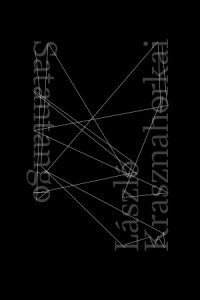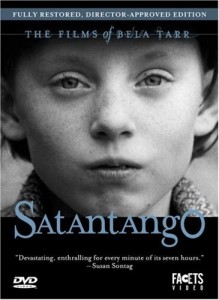Notes on Satantango (the Book and the Film) – Part 1/3
 Satantango
Satantango
by László Krasznahorkai
Translated by George Szirtes
New Directions, 2012
288 pages / $25.95 Buy from New Directions or Amazon
&
 Satantango
Satantango
Directed by Béla Tarr
Screenplay by Lászlo Krasznahorkai
DVD: Facets Video, 2008
435 minutes / Available on Amazon
Released in Hungarian in 1985, Satantango, László Krasznahorkai’s first book, was translated into English only last year. Published by New Directions, the novel displays the melancholy, bleakness, and long sentences that define Krasznahorkai’s other books (War & War, The Melancholy of Resistance, etc.).
Krasznahorkai’s collaborator and fellow apocalypse maker Béla Tarr adapted the 288-page novel into a seven-hour film in 1994. Because of the duration between the appearance of the film and the publication of the English translation, we (like most) had watched Tarr’s adaptation long before reading its antecedent. This reversal of the traditional adaptation-viewing chronology (in addition to Krasznahorkai’s role as screenwriter) makes it difficult to think of the novel independent of the film. But despite the convergence of the two forms of Satantango, we do not believe the demands of the long take are the same as those of the long sentence.
What follows is a collection of take-by-take notes on disc one of the film and the corresponding passages of the novel. (Notes on discs two and three are forthcoming.) Our time stamps are based on the Facets Satantango DVD (2008). Throughout the notes, we acknowledge differences between the novel’s content and the film’s content, as well as translation differences between the novel and the DVD’s subtitles.
***
We see a cow emerge from behind the building, nothing in front of him but a vast scene of thick mud with glimmering streaks of wetness that resemble the trails that snails make when they zigzag across dark pavement. One cow becomes many, and they slowly make their way together. No one leads them or chases them but they seem to know their way. They take their time. They have, it seems, all the time in the world. One even pauses to mount another. This scene, though absent from the novel, sets a haunting tone of obliteration for the film. We watch the cows, then continue to watch, continue to watch past the time of watching, past the time of a simple a gaze or witnessing, look at them for so long that when the camera finally moves away from the herd of animals and pans past the dilapidated buildings, the mundane and bleak textures, the strange marks and letters, the utter signs of disintegration and decay become for us a relief. The wind howls and it feels like silence, yet it is not silent. We can hear the cows’ feet move through the mud, the mooing; the sounds are almost daunting, eerie. Without music (we keep waiting for it, hoping it will come to shake us out of the strange unreal reality of this scene, random sounds that seem to anticipate some cohesive and introductory soundtrack), the scene is discomforting but mesmerizing. Here, inside the muddy world we have found ourselves in, we learn to wait.
[1:35–9:06 / not in novel]
In voiceover:
“One October morning before the first drops of the long autumn rains, which turn tracks into bog, which cut the town off, which fell on parched soil, Futaki was awakened by the sound of bells.” (Satantango, film)
“One morning near the end of October not long before the first drops of the mercilessly long autumn rains began to fall on the cracked and saline soil on the western side of the estate (later the stinking yellow sea of mud would render footpaths impassable and put the town too beyond reach) Futaki woke to hear bells.” (Satantango, novel, page 3)
[9:06–9:50 / page 3]
THE NEWS IS THEY ARE COMING / NEWS OF THEIR COMING
We become complicit in anticipating THEM.
[9:50–9:58 / page 3]
There’s a window centered at the top of the frame. We can hear a sort of musical drone and subtle bells as the room and window grow brighter. At 11:15, there’s off-screen noise—the sound of Futaki removing bed sheets, we surmise. (Note that there’s no clock sound yet.) We come to consciousness with Futaki as he stands and limps to the window at 11:40. He’s wearing a sleeveless shirt and shorts. The room, a kitchen, is now visible. The sound stops, and Futaki comes back toward the camera. The ringing starts up again and he returns to the window. It stops once more and Futaki comes back to the bed. (In the novel, this scene contains a penetrating intrusion into Futaki’s thoughts.) “What is it?” asks Mrs. Schmidt, beginning the film’s first dialogue. Futaki tells her to go to sleep, then says he’ll “pick up [his] share tonight” or the following day.
[9:58–14:17 / page 4]
The camera has turned 45 degrees to the right, facing a small fridge and another table. Shod with laceless high-tops, Mrs. Schmidt crosses the frame from right to left. She moves almost out of frame to take a rag from the door; then she comes toward the camera, raises her nightdress, and squats over a pan. No face. Her head is on her left knee. She splashes water up at her crotch and then stands to wipe with the towel. She exits at left. A fly comes into frame. In the novel, Mrs. Schmidt is a sour-smelling woman. In the film, we have instead this sour-looking image of her. It’s significant that this scene comes so early in the film: an introduction to a quotidian perdition.
[14:17–15:33 / not in novel]
Mrs. Schmidt’s back is to the camera. She’s sitting at the table/window among a collision of patterns: wallpaper, curtains, table cloth, seat cushions, bureau cloth. Off screen (from bed), Futaki asks her, “You had a bad dream?” At 15:42, the fly appears on the seat cushion, hums.
Her dream: “…he was shouting…couldn’t make out what…I had no voice…. Then Mrs. Halics looks in, grinning…she disappeared…. He kept kicking the door… In crashed the door…. Suddenly he was lying under the kitchen table…. Then the ground moved under my feet….”
Futaki’s reply: “I was awakened by bells.”
Alarmed, Mrs. Schmidt looks over her left shoulder and asks, “Where? Here?”
“They tolled twice,” says Futaki.
“We’ll go mad in the end.”
“No,” says Futaki. “I’m sure something’s going to happen today.” (Our introduction to the anticipation that’s central to Satantango.) Does Mrs. Schmidt smile at this?
Like the bells that Futaki hears, Mrs. Schmidt’s dream is proleptic: Schmidt comes to the door, and Futaki shuffles off.
[15:33–17:50 / pages 6–7]
Though the density of text in the novel (there are no paragraph breaks) creates a lack of a clear hierarchy of action or language, in the film we follow the camera’s cue, the camera’s gaze. As Futaki hides in the other room, we stay on his side of the door. A mini-drama unfolds on the other side, but we are prevented from being invested in that. Or at least our distance from the scene doesn’t allow for that kind of emotional complacency, at least not yet. We wait with Futaki. Even after Futaki enters the other side to retrieve his cane and exists for a moment in that other space, currently inaccessible to us, the camera chooses to linger here. The indifference of the scene, the door, the camera. Then, with the waiting, the textures of the wallpaper and curtains starts to take on a strange form, as when you stare at a word too long and it begins to morph into something unnatural.
[17:50–20:10 / page 7–8]
There is the strange frantic hurriedness in the novel as Futaki internally exclaims about the temporary intruder (though perhaps it is arguable who is the intruder in any particular situation), “He’s going to take a leak!” In the film we are a silent observer of Futaki silently observing Mr. Schmidt taking a leak outside in the now very familiar Beckettian mud.
[20:10–21:34 / page 8]
November 25th, 2013 / 12:24 pm
